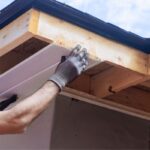Mold in your basement is a dangerous and unsightly invader. The EPA states that it takes just a small amount of moisture to start spores from naturally occurring mold spores growing rapidly. Low airflow in basements can lead to mold growth and damage your property and health.
Must Read: revitalize your home with excellent home improvement ideas
Mold removal in basements can be difficult. It can be overwhelming and can be hard to tell when you should call in professionals and what you can do yourself. This guide will help you understand the basics of mold removal in basements, as well as the steps and tools you can use to remove it. It also explains when to call a professional.
How can you remove mold from your basement?
Mold is an organic way that the environment reduces organic debris. There are tiny mold spores everywhere. Mold spores can either grow on damp surfaces or attempt to destroy the item they are growing on.
There are many types of mold. However, it is easy to recognize each type once you have a basic understanding of their characteristics. It’s easy to identify the type of mold by knowing where to look. Mold can grow in damp areas such as HVAC condensation, pipe leaks or unsealed basement walls. You can often find mold growth areas by looking around HVAC units and under overhead pipes.
Never Miss: psychology of color for interior design and why we should study it
How to test your basement for mold
There are many kits available that can be used to collect samples and send them to a laboratory for testing. This kit is also available at an affordable price on Amazon. To get to the laboratory, simply follow the instructions.
Although testing is easy, it is important to immediately stop any mold growth in basements. Although some molds can be more harmful than others, the CDC says that all molds must be eliminated. It doesn’t matter what type of mold is in your basement.
There are many types of basement mold
Five types of mold are listed by the National Institute of Environmental Health Sciences, (NIEHS), as the most prevalent.
Cladosporium is a type of mold that grows in soils and organic materials around the globe. It is usually brown but can also grow black or grey. This mold is slow-growing.
Penicillium: This is a common antibiotic penicillin that was developed and manufactured. It is fast-growing, usually green, and can be found all over the globe.
Aspergillus is a fungus that can be found both outdoors and indoors. Most people are able to tolerate it. In rare cases, however, it can cause Aspergillosis, which can be extremely harmful to those with weak immune systems or lung conditions like asthma.
Alternaria: This mold is fast-growing, brown, olive, and black. It can cause serious infections but most cases are rare and are accompanied by an underlying condition.
Stachybotrys Chartarum: Also known by toxic black mold, Stachybotrys chartsarum is fast-growing and black in color. It thrives on building materials such as drywall, wood and wallpaper.
Most Popular: how an interior designer can increase the value of your property
Three steps to eliminate mold from your basement
The CDC states that you can’t eliminate all mold spores from your basement. However, you can remove the moisture source and the mold that has grown there. These steps, as suggested by the CDC or EPA, will help to eliminate mold from your basement.
Step 1: Stop the source of moisture as soon as possible to stop mold growth
You may need to make extensive repairs depending on the severity of the problem. You should immediately repair or hire a professional to fix a leaky pipe or condensation in your HVAC system. To dry out moisture from basement walls, a dehumidifier can be used.
Step 2: If possible, remove any moldy material
You can replace the damaged material yourself if the mold has not caused any damage to the soft or fibrous materials, such as carpet or ceiling tiles. Protective eyewear, disposable dust masks, gloves and protective clothing are essential to ensure that mold doesn’t get into your living space.
Step 3: Remove any moldy materials that are not easily replaced
Use a bleach solution (1 cup bleach per gallon water) or commercial cleaners to clean walls and floors. Make sure you wear the same protective gear as in step 2. Disposable sponges and other cleaning products can be thrown away to prevent spreading the spores throughout your house.
You will need the following products and tools to eliminate mold from basements
A dusk mask, or respirator: While you don’t necessarily need a respirator that is medical-grade or professional-grade, it will help protect you from the harmful effects of mold while you work around it.
Eye protection: Protect your eyes from mold spores when cleaning up or using harsh chemicals such as bleach.
- Disposable gloves
- Stiff-bristled brush
Disposable sponge: A disposable sponge is all you need to prevent mold spots from growing on smoother or harder surfaces.
Mold stain removal: Although it is not necessary to actually remove mold, you will likely see a dark spot on the material where the mold was growing. You’ll need a product that can remove it. You can also remove old stains to make it easier to recognize new mold growth.
Bleach: According to the CDC, 1 cup (8 ounces), of bleach mixed with 1 gallon water will kill any mold growth on surfaces.
Use measuring marks to clean the bucket.
Spray bottles: A spray bottle can be used to treat mold spots, whether you need bleach or one the natural remedies discussed below.
Are you averse to chemicals? Here are some natural ways to eliminate mold from your basement
It’s understandable that some people don’t want to use harsh chemicals to clean mold in their homes, especially if the problem is small and manageable. There are many natural ways to get rid of mold.
Baking soda and vinegar are both acidic, and can be used to kill spores and scrub off mold. Make a mixture of half-water and half-vinegar, spray the mold, let it sit overnight, then scrub the area with soapy water the next day. Make a paste with 50:50 baking soda and enough water to be used as an abrasive scrub. Or, mix 2 tablespoons baking soda with 2 cups water in a spray bottle. Spray the solution onto the area and scrub.
These methods can be effective at getting rid of mold from basements. However, it is possible for more serious problems to require professional intervention.
When it is time to hire a professional to remove mold from your basement
While most basement mold cases can be solved with the techniques discussed in this guide, major problems such as hidden moisture leaks or floods or ruptured pipes may cause mold growth to explode in materials that need to be replaced. If you have extensive mold problems, it is best to hire a professional mold remediation company.
Also Read: reasons to work with an interior design specialist
American Council for Accredited Certificate (ACAC) mold certification means that companies have the ability to safely remove moldy material from surfaces and repair damaged surfaces. These businesses specialize in basement encapsulation, which helps prevent mold growth in basements.






